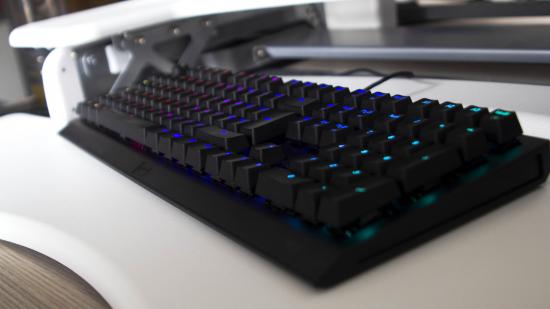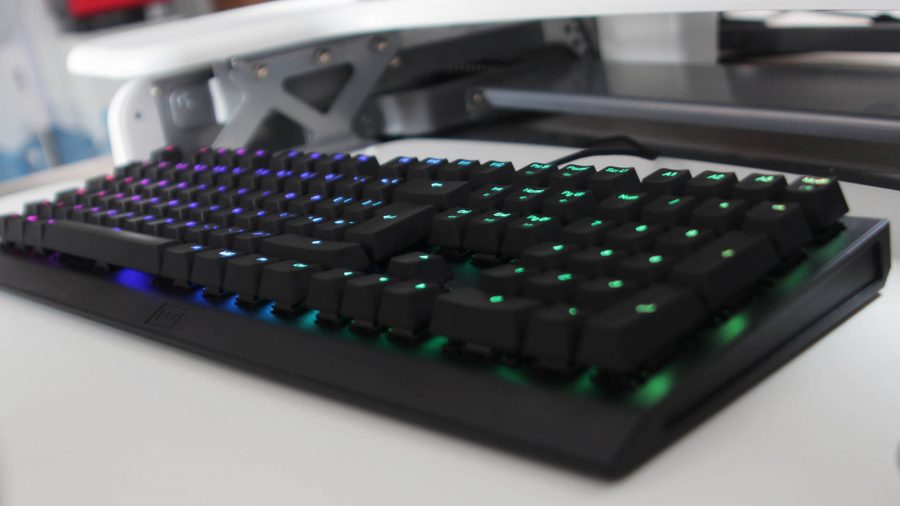Our Verdict
A keyboard requested by the community and delivered by a company keen on value and quality above all else; the Wooting Two is a slam dunk.
This gaming keyboard carries a prestigious name here at PCGamesN. Its predecessor, the Wooting One, already net a sparkling review from us last year, and we’ve since had enough hands-on time with its larger compatriot, the aptly-named Wooting Two, to see how this analogue switch touting, optical gaming keyboard has shaped up since its inaugural appearance.
The Wooting Two retains the personal touch that made the One something special, the handiwork of a small team of three from the Netherlands. It’s also a real crowd-pleaser, with the Wooting Two project finding its feet after many community requests and the subsequent Kickstarter campaign receiving €136,041 and easily flying past its set targets.
The main difference between the Wooting One and the Wooting Two is the size. The former is a tenkeyless compact design, while the latter is a full-size keyboard with the full suite of keypad numeric keys. As such, the Wooting One isn’t going anywhere, and is not being replaced by the Wooting Two, so don’t worry about the smaller model disappearing.
Beyond the extra keys, much of what made the Wooting One great remains exactly the same. If you’re not familiar, let’s rundown the best bits.
First off, this keyboard is optical. You may have heard that phrase bandied around the gaming sphere this last year, but the Wooting puts this technology to good use in a way few others do right now. Rather than its switches existing in a simple on/off state, the Wooting is analogue. That means each switch – and all are optical not just a few select keys – are able to measure the distance they’ve been depressed by a user.
| Wooting Two | Wooting One | |
| Switches | Flaretech | Flaretech |
| Size | Full-size | Tenkeyless |
| Cable | Detachable USB Type-C to USB Type-A | Detachable Micro USB to USB Type-A |
| Rollover | N-key | N-key |
| RGB lighting | ||
| Price | $160 (€160) | $140 (€140) |
Why, you ask? Well, this means you can have switches that operate as one input on a half-press and another on a full press, or even a whole lot more inbetween. Particularly pertinent to the gaming sphere, you can have your directional control analogue like that of a controller, turning a quarter-press slow walk in-game into a 100m, full-on sprint with a complete keypress. All the while retaining full mouse accuracy often required to maintain that competitive edge in PC gaming.
This is achieved through the Flaretech switch and the Wooting’s unique PCB design. Available in three flavours – red, blue, and black (you know the drill) – these switches utilise light, rather than metal contacts, to measure each key press across many measurable points. With fewer mechanical contact points than regular switches, they are also rated to 100,000,000 clicks.
And you can forget about soldering, too. Like some enthusiast mechanical boards, Flaretech’s switches are easily removed and swapped out on a switch-by-switch basis. If you want clicky across the board you only need the spare switches to make the swap. You can buy these from the Wooting store if you fancy: a pack of 110 of any colour setting you back €50 or a pack of 15 for €15.
You needn’t sacrifice anything for those switches either; be that price, performance, or style. And yes, the Wooting Two has full per-key RGB. This is addressable via the Wootility, a superb bit of software that is succinct and easy to use.
The Wooting Two has four layers: three analogue and one digital. The latter is essentially your bog-standard keyboard, rainbow wave effects and all. Meanwhile, the other three layers are accessible via the A1, A2, and A3 shortcuts above the keypad, which will switch between user-configurable analogue layers. These can also be tailored to your favourite titles, or genres, via the Wootility, with analogue bindings available on a per-key basis.
No matter the layer, the actuation point is configurable in-app, anywhere from 1.5mm rapid-fire speed to 3.6mm for heavy typists. For the most part the popular Cherry MX switches actuate around 2mm, with speedier switches from Cherry and Kailh dropping up to the 1.1mm mark. Personally, I hovered around 1.6mm for a heady mix of typing without mistypes and gaming prowess.
Analogue profile 1 is your best bet for most FPS titles. This will simply bind your WSAD keys to controller joystick up, down, etc. The best bit about this solution is that it’s software agnostic, meaning a game needn’t specifically offer support for the Wooting to work, only gamepad support. Failing that, the Wooting Two is also just a regular keyboard – no strings attached.
If you weren’t a part of the Kickstarter you can pre-order the Wooting 2 over at the official web store for $160 (€160). There are various options available, including your pick of switches and ISO/ANSI layouts depending on your location, with the next batch of pre-order stock arriving in September for the popular combos that are already sold out.
With a construction as hardy and clean-cut as the last, and an approach yet to be mimicked effectively by anyone else in the market, the Wooting continues to offer a product that players are hungry for. While the company behind it may be small, it offers a product with a compelling price that somehow avoids pricing pitfalls of crowd-funded projects.
Does it live up to the reputation of the Wooting One? Absolutely. We’re once again staring at gaming keyboard royalty from a tiny team of go-getters that are yet to put a foot out of line, and it’s absolutely a recommendation from us.

